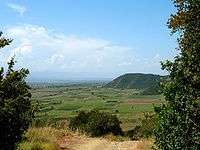Alazani
| Alazani | |
|---|---|
 Alazani River near Akhmeta | |
| Country | Georgia and Azerbaijan |
| Basin | |
| Main source | the Greater Caucasus Range |
| River mouth | Kura in Mingəçevir, Azerbaijan |
| Basin size | 10,800 km2 (4,200 sq mi) |
| Physical characteristics | |
| Length | 351 km (218 mi) |


The Alazani (Georgian: ალაზანი, Azerbaijani: Qanıx) is a river that flows through the Caucasus. It is the main tributary of the Kura in eastern Georgia, and flows for 351 kilometres (218 mi). Part of its path forms the border between Georgia and Azerbaijan, before it meets the Kura at the Mingəçevir Reservoir.
The Alazani originates in the Greater Caucasus, south of the main ridge, in the northwestern part of the Akhmeta District. It flows initially to the south towards the town Akhmeta, then through the fruitful Alazani Valley of Kakheti towards the southeast. The Alazani is the center of the Georgian wine industry. For centuries, it was a main gateway for Persian invaders.
The Alazani dries up during the winter, but in the late spring, snow melt from the mountains swells the river enormously; this regularly causes flooding. The river is mainly used for irrigation and for drinking water. In the 1990s, Chinese investors built many small hydroelectric power plants, which use the Alazani's strong current. The river is also popular with tourists for rafting trips.
A light pollution of the river with biological substances comes from untreated sewage from the cities and other communities, as well as from the agricultural areas. In the districts of Kvareli and Lagodekhi, water quality is said to be quite bad.
Alazani serves also as the name of different Georgian wines, among them the semi-dry brands of Marani Alazani Valley and Old Tbilisi Alazani.
References
- The information in this article is a based on and/or translated from that in its German equivalent.
- Alazani at GEOnet Names Server
| Wikimedia Commons has media related to Alazani River. |
Coordinates: 42°22′N 45°37′E / 42.367°N 45.617°E